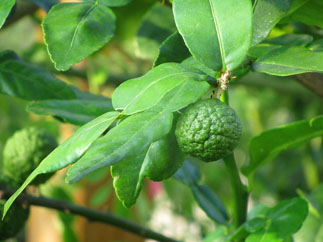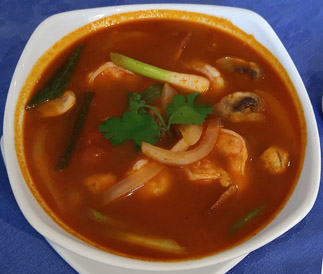Kaffir lime leaves
Kaffir lime leaves are oblong-shaped, dark green, glossy leaves, growing in pairs of a plant in the citrus (Rutaceae) family. The leaves, as well as the fruit, are full of citrus flavor that gives the distinctive lemon aroma and flavor to Thai, Malay, and Indonesian cooking.
Scientific name: Citrus hystrix.
 |
| Kaffir (Makrut) lime plant Courtesy: Katja Schulz |
Also known by Makrut limes, Bai Magrood, Thai lime, Limau Puru, etc., the kaffir lime plant is closely related to oranges, lemons, pomelos, and grapefruit.
The kaffir lime tree is a thorny bush native to tropical Southeast Asia that can grow to be 3-5 meters in height. Its cultivation has spread to neighboring regions through exporters and trade routes.
The leaves of the kaffir lime are thick, dark green color with a glossy sheen, grow in pairs, and look like a figure of eight, measuring 3-5 centimeters in diameter and 7-10 centimeters in length.
Kaffir lime leaves and peels are aromatic and used as spices for various flavoring purposes such as seasoning or preparing savory curry pastes.
Kaffir lime fruit
Kaffir lime fruit is a small orange-sized citrus fruit from this bush, which has a thick peel with a bumpy surface.
They are green when raw and turn greenish-yellow when fully ripe. They are used to prepare pickles, sherbet, and acidifying agents in curries in Southeast Asian cooking.
Health benefits of kaffir lime
Kaffir lime leaves and fruit peel contains the essential oil citronellal which is responsible for the citrus fragrance to it. The other main components are limonene, nerol, and pinene.
Kaffir lime leaves, used for fragrance in cooking, contain many notable plant-derived compounds, minerals, and vitamins that are essential for optimum health.
Fresh leaves of makrut lime are low in calories. Nonetheless, they carry ample amounts of soluble and insoluble fiber that helps in the reduction of serum LDL cholesterol levels as well as in smooth bowel movements.
Its fresh leaves and herb parts are very rich in folates. Folates are important in DNA synthesis and when given during the peri-conception period can help prevent neural tube defects in the baby.
Kaffir lime leaves are an excellent source of vitamin A, carotenes, and xanthin anti-oxidants. Consumption of natural foods rich in carotenoid compounds and vitamin A has been found to help protect from lung and oral cavity cancers.
The zesty leaves are a very good source of many vitamins such as thiamin, niacin, pyridoxine, pantothenic acid, and riboflavin. These B-complex groups of vitamins help in enzyme synthesis, nervous system function, and regulating body metabolism.
Kaffir lime leaves also contain a good amount of minerals like calcium, copper, iron, potassium, magnesium, manganese, zinc, and selenium.
Medicinal uses of makrut (kaffir) lime leaves and fruits
The leaf extracts were reported to have antioxidant, anti-cancer, and anti-inflammatory activities.
In Thailand, makrut lime juice is employed to cleanse the blood, improve appetite, and keep skin and hair in good health.
They are also believed to have cancer-fighting and liver-protecting properties.
Selection
Kaffir (Makrut) lime leaves and fruits are available in fresh markets in specialty grocers in South and Eastern parts of India, Southeast Asia, and South Africa. In the United States and Canada, one can find them in Asian stores selling fresh herbs and fruits.
Kaffir lime trees are commonly found and frequently used in India, Myanmar, Sri Lanka, and Thailand; the majority of rural households have their own trees growing in their backyards.
Choose fresh, dark green, shiny leaves imparting a fresh citrus scent. Avoid wilted, yellow-discolored leaves.
Makrut lime fruits should feature deep-green, bright skin and should emit a citrusy fragrance when rubbed with the thumb.
Storage
Generally, fresh leaves are preferred in cooking. However, they will keep up to two weeks when stored fresh in the refrigerator.
Keep makrut lime fruits in a fruit basket at room temperature for 2-3 days and in the refrigerator for up to 4-5 days. However, extended storage would result in chill injury.
Culinary uses
In Thailand, Laos, Cambodia, and Malaysia, makrut lime leaves and peels are used as spices for various flavoring purposes such as seasoning or preparing savory curry pastes.
To prepare, kaffir lime leaves are washed in clean running water and mopped dry using a paper towel.
The thick leaves are never consumed whole, but rather steeped and later removed, or sliced very thinly.
Kaffir lime leaves pair well with fellow herbs and spices such as lemongrass, Thai basil, cardamom, curry leaves, spearmint, cumin, galangal, ginger, and garlic. It gels easily with Southeast Asian ingredients like coconut milk, soy sauce, tamarind, sesame oil, Thai jasmine rice, meats such as lamb, chicken and pork, and seafood.
Makrut (kaffir) lime leaves are thick and fleshy. They should not be consumed whole but rather crushed/shredded and steeped in boiling water and later removed, or sliced very thinly to use in soups, curries, and stir-fries.
Here are some serving tips:
 |
| Tom-Yam-Gung (Shrimp Curry Soup). Courtesy: Haydn Blackey |
In Thailand, makrut lime leaves are widely used in soups such as tom yum [ต้มยำ], a flavorful hot and sour using shrimps (tom yam gung [ต้มยำกุ้ง]), chicken (tom yam gai [ต้มยำไก่]) or fish (tom yam pla [ต้มยำปลา]) and vegetable curries, fried rice, and stir-fries.
The leaves are widely used in chicken and fish recipes in Malay, Indonesian and Balinese cuisine.
Their citrus flavor can be used to infuse teas and desserts such as custard and ice cream.
In India, Kaffir lime fruits are indeed more popular than leaves. The fruit juice, which is very sour and has the same fragrance as the leaves, is sometimes added to vegetable rice dishes as a substitute for lemon/lime juice.
In South India, the kaffir fruits are also employed in pickle.
Safety profile
Allergy to Kaffir lime leaves and fruits is rare. The leaves are healthy and do not cause any side effects in pregnant and nursing mothers when consumed in small quantities.
(Medical disclaimer: The information and reference guides on this website are intended solely for the general information of the reader. It is not to be used to diagnose health problems or for treatment purposes. It is not a substitute for medical care provided by a licensed and qualified health professional. Please consult your health care provider for any advice on medications.)
Also read ≻≻-
≻≻- Curry leaves nutrition facts, medicinal uses and health benefits.
≻≻-Back to Herbs from Kaffir lime leaves. Visit here for an impressive list of healthy Herbs with complete illustrations of their nutrition facts and health benefits.
≻≻-Back to Home page.
Further reading:
Kaffir Lime Fact Sheet-Kaffir lime leaf and peel. (opens in pdf).
Gernot-Katzer's spice pages. (Opens in new window).
Kaffir lime (Makroot) leaves- Specialty produce. (opens in excel).
Antileukemic Cell Proliferation of Active Compounds from Kaffir Lime (Citrus hystrix) Leaves-National Center for Biotechnology Information, U.S. National Library of Medicine.